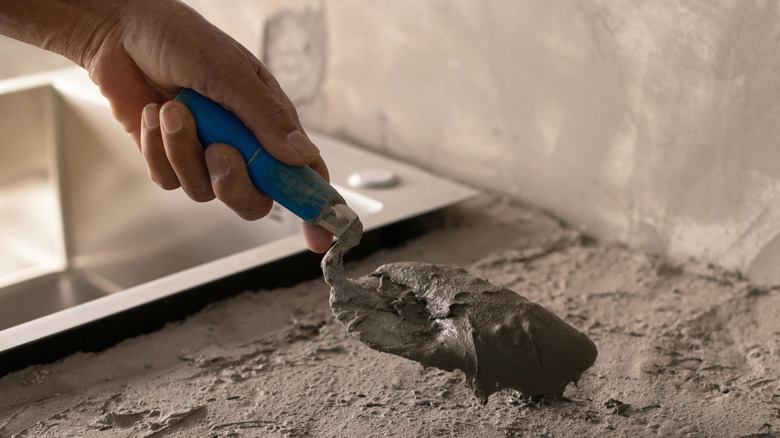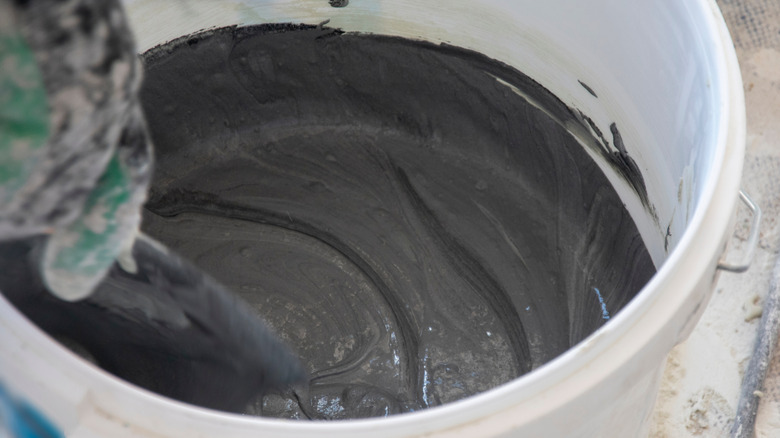Cement Over Granite Countertops For A Simple DIY Update
Covering up your countertops with microcement can be the perfect solution for a complete and fairly quick bathroom or kitchen makeover. The seamless, raw look of cement can complement intricate tile walls and backsplashes or be the star of the show in sophisticated modern décor. For instance, if a heavily speckled brown or black granite countertop style is making your home look dated, it only takes about four days and a few coats of product to turn it around.
Although professional help is always advised, cementing granite countertops is fairly doable for experienced DIYers. With so many brands on the market, all with their own specificities, it's essential that you follow the manufacturer's instructions. These tell you how many coats are needed, how long they take to dry, and whether or not you need to prime and sand down the original countertop. Because microcement can adhere to most surfaces (including floors, walls, and countertops) and substrates (such as concrete, tile, stone, and even wood), it's a relatively uncomplicated material to use if you do it right.
What is microcement?
Microcement is a powdered mix of cement, quartz, and other additives that creates a smooth, peanut butter-like paste when combined with water. It achieves a specific, super-trendy look suggestive of concrete that's a mainstay in any ultimate guide to minimalist décor. It's highly versatile and can be mixed with pigments, dyes, oxides, and stains to achieve a smooth, rough, shiny, or matte texture and finish, fitting virtually any aesthetic.
Unlike concrete, microcement gets its name from how thin the required coats are. Its total thickness is usually 2 to 3 millimeters, although it may require up to seven layers depending on the surface and desired look. Without the need to tear down existing materials or structures, microcement is an exceptional option for budget-friendly home upgrades that can save you a full remodel. Moreover, with the right primer and sealant, this concrete-like overlay becomes nonporous, stain-resistant, waterproof, and food-safe, making it particularly popular for bathroom and kitchen DIYs.
How to cement a granite countertop
For this DIY, you need your fair share of equipment. Before getting down to business, make sure you're protected: Gloves, a mask, and a well-ventilated area are advised. Next, prepare the room by covering adjacent areas with masking tape and plastic sheets. Microcement's strong adhesion is both a blessing and a curse, so you don't want it getting anywhere it's not meant to.
Focusing on the countertop, start by thoroughly cleaning and drying it. Additionally, some manufacturers require old sealer be removed; steel wool, chemical strippers, or sandpaper may do the job. Make sure your countertop is perfectly smooth before moving on to the primer by filling in any joints and cracks using a grout filler. For convenience, consider a microcement DIY kit equipped with the designated primer and sealant. Some may not need priming, though, so follow your product's instructions closely. Prepare the primer and apply it with a foam roller, letting it dry as long as recommended.
Now for the fun part: Using a mixing tool, carefully and thoroughly blend cement powder and liquid. This plaster hardens quickly, so don't make too much. Apply using a flexible spatula for a thickness of 1 to 2 millimeters; any more or less can lead to cracking. After 24 hours, sand down that first coat. Once it's smooth, you may need another coat of primer. If not, just continue onto the second coat of microcement, following the same process as before. If you're happy with the result, finish it off with a high-quality sealant that's waterproof and food-safe. Et voilà! Brand new countertops.

